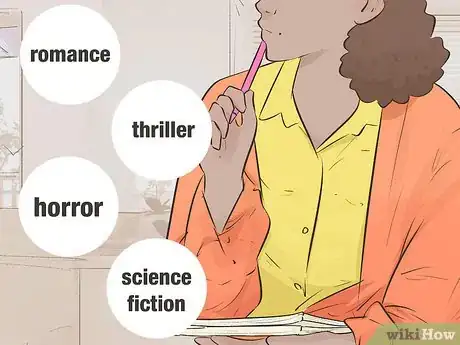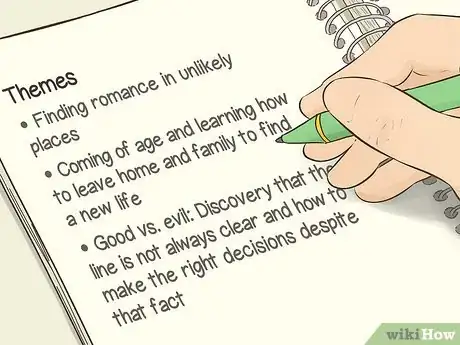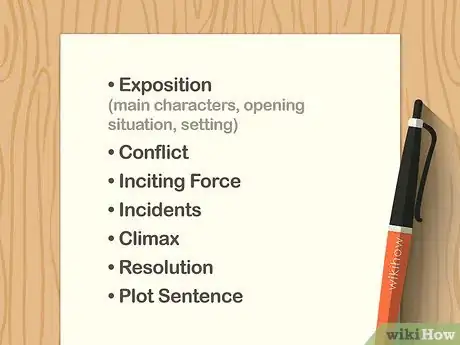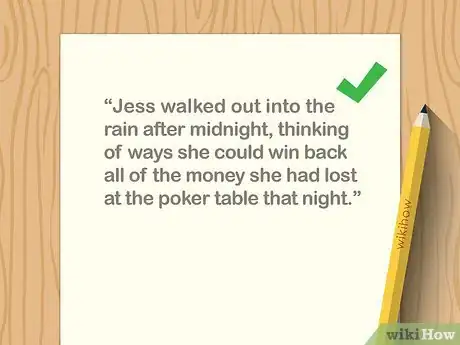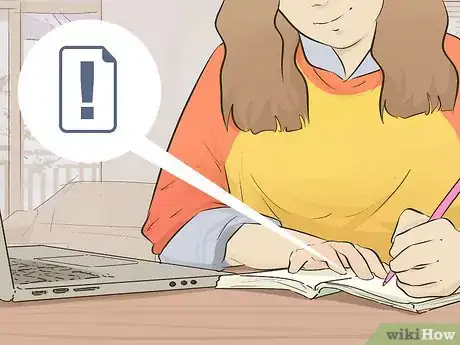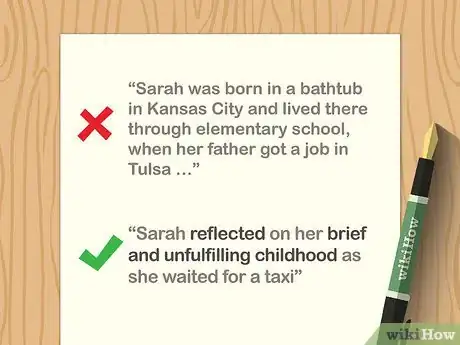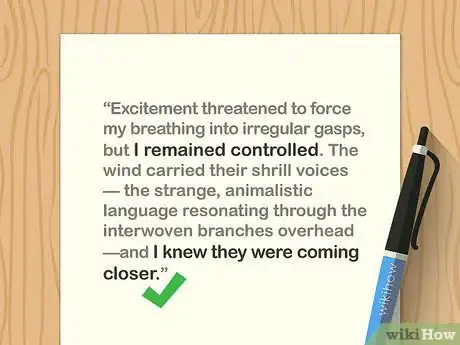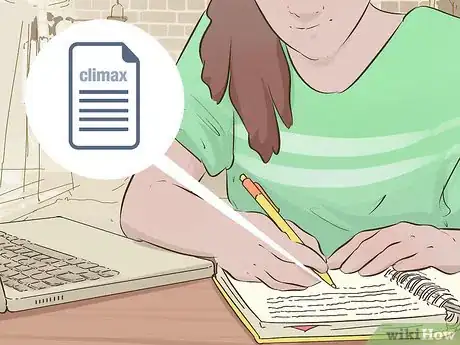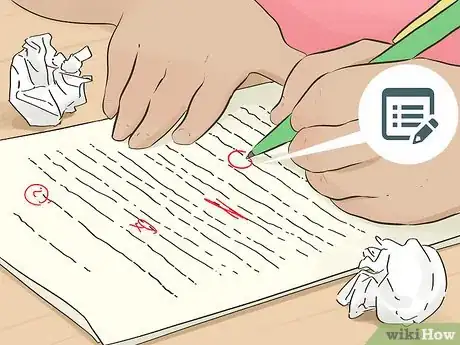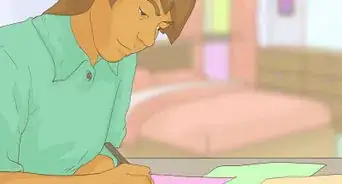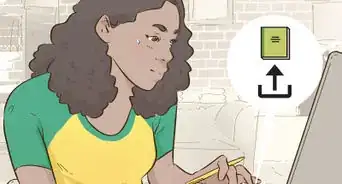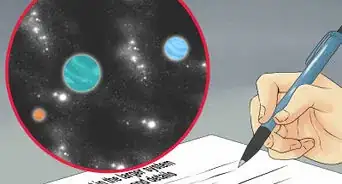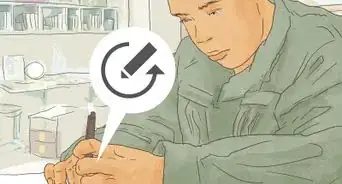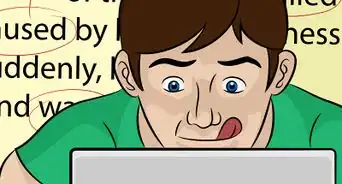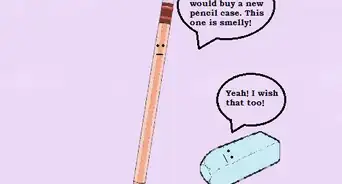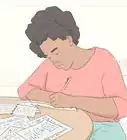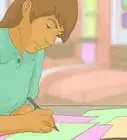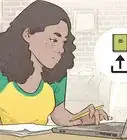This article was co-authored by wikiHow staff writer, Hunter Rising, and Julia Martins, a trusted member of wikiHow's volunteer community. Julia Martins is an aspiring writer currently living in San Francisco, California. She graduated from Stanford University with a BA in English and has been published in Cornell University's Rainy Day Magazine, Stanford University's Leland Quarterly, and Bards and Sages Quarterly.
There are 7 references cited in this article, which can be found at the bottom of the page.
This article has been viewed 113,952 times.
Learn more...
Flash fiction, also known as micro-fiction, is a short story that’s usually between 500 and 1,000 words. When writing a flash fiction story, use each sentence to move the plot forward to tell a complete narrative. If you want to start working on flash fiction, make sure to choose an interesting theme and character to keep readers interested. After you outline and write your flash fiction, you need to edit your work to make sure it’s concise. When you’re finished, you’ll have a story you can share with others!
Steps
Creating a Theme and Characters
-
1Pick a genre for your writing. Flash fiction can be in any genre you’d like, but popular genres to choose from include romance, thriller, horror, and science fiction. Each genre has its own tropes to help you shape a unique story. Brainstorm the type of narrative you’d like to write and like to read so you can start thinking of ideas.[1]
- If you like to write suspenseful stories, try doing a thriller or horror flash fiction piece.
- For stories that take place in the future or have advanced technology, write science fiction.
- If you want to focus on a relationship, consider writing romantic flash fiction.
-
2Choose an overarching theme for your flash fiction story. The theme is the main moral argument of your story and the message you want to leave with your readers. Some common themes you can use for your flash fiction include love, family, death, and power. Write down what themes you may want to use for your story so you can use them to influence your character and plot.[2]
- For example, if you want your theme to be love and sacrifice, you may choose to write a story about someone who works all the time just to earn money for someone they care about.
Tip: Use symbols to help convey your theme subtly. For example, a dove can represent peace after a war, or a rose can symbolize love.
Advertisement -
3Create an interesting and flawed protagonist. Your main character needs to have a motivation and goals in order to progress through your writing. Make their motivations believable so your readers can relate to them easily. Give your protagonist some flaws so they aren’t perfect and have difficulty achieving their goals. Only focus on 1 character since your flash fiction piece needs to be short.[3]
- For example, your protagonist’s goal may be to find sunken treasure, but they’re afraid of the ocean.
- Only give your character 1 goal for your flash fiction or else your piece could get too long or complicated.
-
4Choose an antagonist that your main character needs to overcome. The antagonist is the main force fighting against your main character. Your antagonist could be another character, something in nature, or even an internal struggle. Make sure your antagonist directly affects your protagonist and the outcome of your story.[4]
- For example, your protagonist could be someone stuck in the forest and your antagonist could be a wolf trying to hunt them.
- Combine an internal struggle with an external struggle to make your flash fiction more complex.
Outlining the Plot of Your Flash Fiction
-
1Pick a single moment in your character’s life to focus on. Since flash fiction is too short to get into the entire life of your character, you need to choose 1 moment to write about. Consider the theme you chose to write your piece around and chose an event related to it. It could be part of an everyday routine or something large that changes your character’s life.[5]
- For example, if your theme is about loss, you may write your flash fiction piece about how someone’s daily routine changes the day after someone they loved passed away.
Tip: Create a character sheet for your protagonist so you can list all of their traits in detail. This way, you know your character well without including it in your actual flash fiction piece.
-
2Start your story with an interesting hook in the middle of the action. Exposition and backstory take up a lot of words when you’re writing a flash fiction piece. Instead of explaining how your character got into a situation, start right when the event occurs. That way, you hook the reader to your story and don’t include boring or unnecessary information.[6]
- For example, you may write something like, “Jess walked out into the rain after midnight, thinking of ways she could win back all of the money she had lost at the poker table that night.”
- If you need to include exposition about your character, work it into their dialogue.
EXPERT TIPBecause flash fiction is so short, starting in the middle of an action immediately gets the reader hooked.
Julia Martins is an aspiring writer currently living in San Francisco, California. She graduated from Stanford University with a BA in English and has been published in Cornell University's Rainy Day Magazine, Stanford University's Leland Quarterly, and Bards and Sages Quarterly.
Julia Martins
BA in English, Stanford University Julia Martins
Julia Martins
BA in English, Stanford University -
3Make your protagonist deal with a single conflict throughout the story. The conflict is what causes tension and creates your story. Use your antagonist to challenge your main character so they have something to overcome. That way, your reader will feel satisfied as your character finishes their arc.
- For example, if you were writing a story about a boxing match, you may have your antagonist wound your main character so it’s more challenging for your protagonist to win the fight.
- Don’t use multiple conflicts in a flash fiction piece since it can get confusing and wordy.
-
4Create a surprise ending. Many flash fiction pieces end with a surprise ending that the reader doesn’t expect. Make the ending is a resolution to the conflict you told throughout your writing but done in a surprising way. That way, your readers will feel satisfied with the story and want to read it again.[7]
- Make sure the surprise fits with the rest of the story. For example, readers would be unsatisfied if a meteor fell out of the sky and stopped a monster from attacking.
- Do your best to avoid jokey twist endings since they’re overused.[8]
Drafting Your Story
-
1Use language that’s descriptive and concise. Make sure all of your character's actions and intentions are clearly communicated through your writing. Aim to write sentences with the fewest number of words you can use while still maintaining clarity. Instead of writing backstory, summarizing the feelings or emotions tied with the events instead.[9]
- For example, if your protagonist’s childhood is relevant to the story, do not write, “Sarah was born in a bathtub in Kansas City and lived there through elementary school, when her father got a job in Tulsa …” Instead, say something like, “Sarah reflected on her brief and unfulfilling childhood as she waited for a taxi.”
- It’s okay to use more than 1,000 words while you’re writing your first draft since you’ll be editing them out later on.
Tip: Look up common words in a thesaurus to find synonyms that are more powerful. For example, instead of saying something is moving slowly, you may instead say that it’s sluggish.
-
2Make each sentence reveal character details and advance the plot. Include your character’s qualities and personality in your sentences so your reader always gets new information about them. Throughout your writing, your reader should learn something new about the character or plot. Don’t include any sentences that are just descriptions or slow the plot down.[10]
- Use your character’s dialogue to help reveal information or progress the plot as well.
-
3Include a few paragraphs after your climax. Flash fiction that ends just after the surprise or twist is revealed may leave readers unsatisfied since they want to know how a character reacts. Dedicate at least the last 1-2 paragraphs to resolve the conflict and let your reader know the outcome of the revelation.[11]
-
4Give your flash fiction a fitting title. Your title should reflect the main ideas or conflict of your story. Brainstorm your theme and the elements of your story to see how you can combine them to make your title. Think of something catchy and easy to read so your reader is more likely to remember it.[12]
- Your title can help describe any backstory that you didn’t include. For example, if you’re writing a story about a husband doing the routine of his wife who passed away, you may call your story “In Her Footsteps.”
Editing Your Work
-
1Cut out words that are unnecessary for the story. Read through your work and make note of any sentences you can write with fewer words. Get rid of common filler words, such as “very,” “quite,” and “actually.” Make sure each word you choose for your story is intentional and has a purpose. As you make edits, read through your story again to make sure it still makes sense.[13]
- Get rid of any information that’s repeated unless you need it to add emphasis.
- Use a thesaurus to find words that are stronger and less common.
-
2Give your story to other people to read and critique. Choose a few people you trust to read through your flash fiction. Tell them exactly what sort of feedback you’re looking for, such as if the story is clear or if it’s interesting. Listen to their feedback when you’re finished and take notes so you know what needs to change in your next revision.[14]
- Be prepared to answer questions about your story in case your reader is confused.
- Talk to a writing professor or teacher to see if you can to see if there’s anything they would edit.
EXPERT TIPIt can be scary to give your writing to other people, but sharing your work and hearing feedback will help you become a better writer.
Julia Martins is an aspiring writer currently living in San Francisco, California. She graduated from Stanford University with a BA in English and has been published in Cornell University's Rainy Day Magazine, Stanford University's Leland Quarterly, and Bards and Sages Quarterly.
Julia Martins
BA in English, Stanford University Julia Martins
Julia Martins
BA in English, Stanford University -
3Make changes until you’re happy with your piece. Continue rewriting and editing your flash fiction until it uses the least number of words. Keep reading your story and asking for feedback after each edit so you know what to work on next if you need to.[15]
- Don’t become too much of a perfectionist or else you’ll always find some flaw in your story.
Expert Q&A
-
QuestionWhat is a good antagonist?
 Julia MartinsJulia Martins is an aspiring writer currently living in San Francisco, California. She graduated from Stanford University with a BA in English and has been published in Cornell University's Rainy Day Magazine, Stanford University's Leland Quarterly, and Bards and Sages Quarterly.
Julia MartinsJulia Martins is an aspiring writer currently living in San Francisco, California. She graduated from Stanford University with a BA in English and has been published in Cornell University's Rainy Day Magazine, Stanford University's Leland Quarterly, and Bards and Sages Quarterly.
BA in English, Stanford University Your antagonist doesn't need to be a person. Depending on your story's theme, sometimes setting your protagonist "against" nature — or even "against" their own personal demons — can be a very compelling story!
Your antagonist doesn't need to be a person. Depending on your story's theme, sometimes setting your protagonist "against" nature — or even "against" their own personal demons — can be a very compelling story! -
QuestionWhat makes a good twist?
 Julia MartinsJulia Martins is an aspiring writer currently living in San Francisco, California. She graduated from Stanford University with a BA in English and has been published in Cornell University's Rainy Day Magazine, Stanford University's Leland Quarterly, and Bards and Sages Quarterly.
Julia MartinsJulia Martins is an aspiring writer currently living in San Francisco, California. She graduated from Stanford University with a BA in English and has been published in Cornell University's Rainy Day Magazine, Stanford University's Leland Quarterly, and Bards and Sages Quarterly.
BA in English, Stanford University Avoid cliché twists. Some common twist endings to avoid are: having your protagonist wake up from a dream, having everyone in the story be secretly related, or the story having been a "prank" everyone was in on. If you want to surprise the reader with a good twist, think of something that will change their interpretation of what the story means!
Avoid cliché twists. Some common twist endings to avoid are: having your protagonist wake up from a dream, having everyone in the story be secretly related, or the story having been a "prank" everyone was in on. If you want to surprise the reader with a good twist, think of something that will change their interpretation of what the story means! -
QuestionI notcied that in most popular flash fictions there's little to no dialog, I was wondering if there's a logic to that?
 Community AnswerMany flash-fiction writers avoid writing dialogue since it takes up a large number of words. In flash-fiction, dialogue need to be limited so that the story does not feel like a scene from a play.
Community AnswerMany flash-fiction writers avoid writing dialogue since it takes up a large number of words. In flash-fiction, dialogue need to be limited so that the story does not feel like a scene from a play.
References
- ↑ https://medium.com/@joannasmith008/everything-you-need-to-know-about-flash-fiction-29e2513b4f4a
- ↑ https://blog.udemy.com/flash-fiction-examples/
- ↑ https://blog.udemy.com/flash-fiction-examples/
- ↑ https://writingcooperative.com/how-to-dramatically-improve-your-flash-fiction-7f2388273afd
- ↑ https://blog.udemy.com/flash-fiction-examples/
- ↑ https://writingcooperative.com/how-to-dramatically-improve-your-flash-fiction-7f2388273afd
- ↑ https://writingcooperative.com/how-to-dramatically-improve-your-flash-fiction-7f2388273afd
- ↑ https://www.reflexfiction.com/how-to-write-flash-fiction/
- ↑ https://blog.udemy.com/flash-fiction-examples/
- ↑ https://medium.com/@joannasmith008/everything-you-need-to-know-about-flash-fiction-29e2513b4f4a
- ↑ https://www.theguardian.com/books/2012/may/14/how-to-write-flash-fiction
- ↑ https://www.theguardian.com/books/2012/may/14/how-to-write-flash-fiction
- ↑ https://writingcooperative.com/how-to-dramatically-improve-your-flash-fiction-7f2388273afd
- ↑ https://writingcooperative.com/how-to-get-good-feedback-on-your-writing-for-free-and-avoid-critiquers-from-hell-df5f91929d88
- ↑ https://jerryjenkins.com/self-editing/
About This Article
If you want to write flash fiction, every word counts, so start your story in the middle of the action, at a moment crucial to the narrative. Devote most of your sentences to developing the conflict rather than setting up the characters’ backstory or describing the scenery. Remember to write concisely, since a flash fiction story is typically only 500-1000 words. Finish strong and try to devote 1-2 paragraphs at the end to resolve any remaining conflicts. Read on to learn how to publish your flash fiction!
